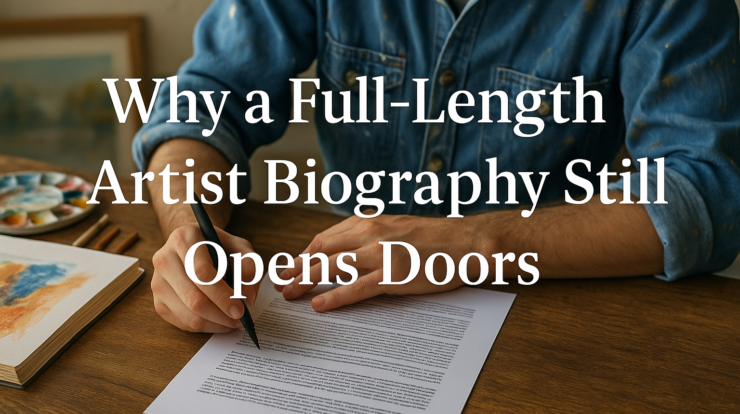
There’s a moment that happens every now and then at the gallery that still catches me a little off guard: a collector walks in, scans the walls, stops in front of a piece, and then—before asking the price, or even the artist’s name—asks, “Do you have anything I can read about the artist?”
They’re not asking for specs. They’re looking for a story.
As artists, you might assume that your work should speak entirely for itself. And while strong artwork is non-negotiable, what I’ve seen time and again is that a well-crafted biography acts as a credibility booster. It gives potential collectors—and gallery owners like me—a deeper sense of who you are, how you’ve arrived at this point in your career, and why your work matters.
Short vs. Long: Do You Need Both?
Many artists tell me they’ve noticed that some galleries request a short bio—just a paragraph or two. That’s true, and it’s a good reason to have a concise version ready. But here’s the mistake I see: artists assume that means a longer biography is unnecessary or unwanted.
It’s not.
The short version is helpful for press releases, websites, or quick introductions. But when you’re submitting to galleries, attending shows, or sending materials to serious collectors, a fuller, thoughtfully written biography signals professionalism and readiness.
The Hidden Power of a Printed Biography
Imagine sending a gallery not just a PDF with a few lines of text, but a well-designed, magazine-style bio that includes photos of your work and studio. It tells your story, yes—but it also shows that you’ve taken the time to invest in your presentation. It makes an impression.
Galleries want to know that if they bring you on, you’re going to be easy to work with—that you’ll meet deadlines, communicate well, and show up prepared. A strong bio does more than narrate your past—it speaks volumes about your future.
“But Who Am I to Write About Myself?”
This is one of the most common objections I hear. You’re not alone in feeling awkward about putting your life story on paper. Maybe you feel your path hasn’t been dramatic enough. Or maybe you’re just uncomfortable “talking yourself up.”
Let me reassure you: nearly every artist I’ve worked with feels this way. And ironically, that humility is often what makes your story relatable and compelling. The key is to step back and let the facts of your life and your journey speak for themselves—framed with just enough perspective to help others understand the artist behind the work.
If writing is not your strength, that’s okay. Some artists hire a professional writer (a strategy I recommend if you want to take the pressure off). Others collaborate with a spouse or trusted friend to capture the right tone.
If you’d like help, our app Theobot was built for this. It will walk you through a few key questions and then help you draft a strong, well-structured artist bio you can refine and build upon.
Don’t Worry If No One Reads Every Word
One final objection I sometimes hear is: “Who’s actually going to read all this?”
Maybe no one. Maybe everyone.
The point isn’t to guarantee that every gallery owner or collector reads your entire bio. The point is to have it ready—because when someone does want more depth, the worst thing you can say is, “I don’t have anything prepared.”
Even a quick skim of a well-laid-out biography gives a sense of your seriousness. And if your work and your story resonate, that bio could be the difference between being remembered and being forgotten.
Start Today
If you don’t have a solid, long-form artist biography, it’s time to write one. Take a weekend and jot down the key milestones in your journey. Ask yourself: What shaped me as an artist? What keeps me coming back to the canvas or the studio? What would I want someone to know if they were about to buy one of my pieces?
Then put it all together in a clean, compelling format.
And if you want a head start, Theobot is ready to help.
Whether you’re applying to galleries, preparing for a show, or just want to level up your professional materials, your biography isn’t just a formality—it’s part of the art.